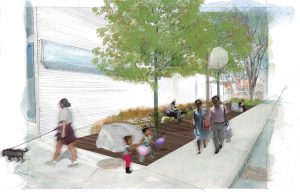Visioning a future for Little Italy

PICTURE COURTESY DTAH: Astra Burka, who organized the discussion on the future of College Street from Bathurst to Shaw streets, lauded the Bloor Annex BIA (whose chair publishes this newspaper) for its plan to transform “a series of left-over parcels of land into a sequence of vibrant, dynamic, public green spaces”.
By Annemarie Brissenden
Is Little Italy a victim of its own success?
That question was top of mind for those attending a meeting on the future of College Street from Bathurst to Shaw streets at the Royal Theatre last month.
Jane Jacobs loomed large as City of Toronto planner Graig Uens moderated a panel of experts from the city during a discussion that was driven largely by questions from the audience.
“In The Death and Life of Great American Cities, Jane Jacobs asked what makes great neighbourhoods start to decline,” said one speaker. “The answer was its outstanding success. I believe that’s the point that College Street is at.”
For Astra Burka, Little Italy began to change around 1990, when making tomato sauce in laneways, baking bread in the early mornings, and gatherings on Friday nights started to give way to absentee landlords, condominiums, and retail chains.
Deciding it was time to develop a long-term plan, she organized the September meeting, bringing residents and businesses together with the city for the first time.
The architect, filmmaker, and self-described urban thinker for the future of Toronto set the stage for the evening with an overview of some of the challenges of College Street, followed by some opportunities for improvement inspired by models from home and abroad.
“Commercial taxes are not equitable…. Two businesses sitting side-by-side can have widely different assessments”—Djanka Gajdel
Imagine, Burka asked, if there was a vision that unified the street and included pop-up shops, inviting and visually interesting storefronts, and viewed the street architecture — like planters and bollards — as a canvas for art?
She contrasted this with College Street as it is right now: a visual chaos made up of overhead wires, fenced-in spaces, and trees failing to thrive. Newspaper boxes line patchwork sidewalks with haphazard concrete squares that are punctuated by empty storefronts.
“If we want to have vibrant and exciting neighbourhoods, we have to figure out how to sustain the tapestry of small businesses,” said Djanka Gajdel. “The commercial taxes are not equitable. This is the underlying issue that is affecting all small businesses. Two businesses sitting side-by-side can have widely different assessments.”
Panelist Rebecca Condon, an economic developer officer for the city, agreed that the assessment process, overseen by the Municipal Property Assessment Corporation (a provincial arm’s-length body) is not transparent.
“Commercial tax streams at three times the residential rate,” said Condon, “and the city is trying to reduce that ratio.”
“The answer is in large part political,” added her colleague Randy McLean. The city’s Beautiful Streets manager explained that “the province sets the rules, while the city acts as a collection agency.”
The situation is made worse by the tax breaks that are given to landlords with commercial spaces that have remained vacant for a certain length of time, disincentivizing them from finding new tenants. It also paves the way for huge box stores?(as much a threat to the area’s character as the empty storefronts), the only ones that can afford the commercial taxes.
For many in the audience, pop-up shops would be a good alternative, as well as small owner-operated businesses that would break up the monoculture of cafés and sushi places.
“Cafés might not be the most creative use of corners or arterial space,” said one audience member. “I’d like to see more creative use of space. I don’t want one type of space.”
“Specific types of retail business that can be viable tend to be market specific,” answered Condon, adding that successful pop-ups need “a champion storefront; a landlord prepared to offer short-term low-rent leases that test out the market viability without requiring a lot of resources up front”.
“One of the hardest things we battle is rents and occupancy,” said Lenny Lombardi, chair of the Little Italy College Street Business Improvement Area (BIA). “The most we can do as a BIA is beautify the street as much as possible.”
Antonella Nicaso, a streetscape designer and capital project coordinator for the city’s BIA office, said that BIAs often trigger a neighbourhood’s rejuvenation.
“BIAs provide excellent solutions, local knowledge, and the ability to maintain projects after they are constructed.”
But Lombardi stressed that the BIA’s mandate is to serve its ratepayers, the business community from Shaw to Bathurst streets.
“Our biggest priority is promotion and generating business for merchants,” he said.
As the evening closed, it was clear that a future direction for College Street was beginning to emerge: burying wires, adding artistic elements and seating, recruiting more small owner-operated businesses, and, mostly, rediscovering what makes the neighbourhood its authentic self.
Burka characterized it as a good first start, but she would like more ideas to emerge.
“We all share the space together. Let’s be crazy and do something. We need imagination. We need guts. We have money. We have talent. Let’s go for it.”
READ MORE:
NEWS: Bloor Street goes green (April 2016)
